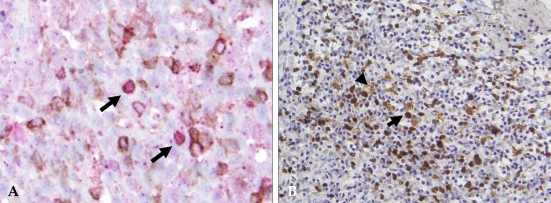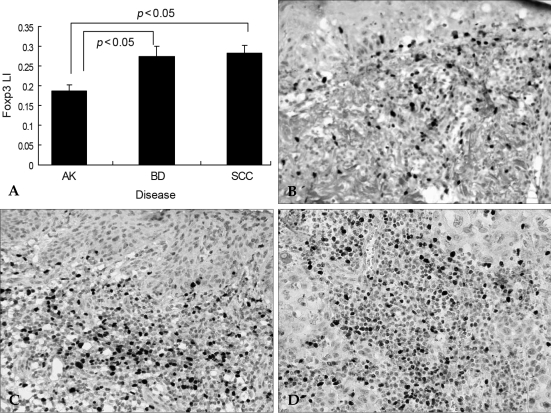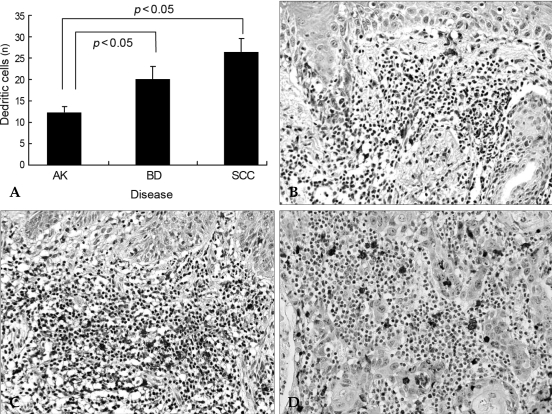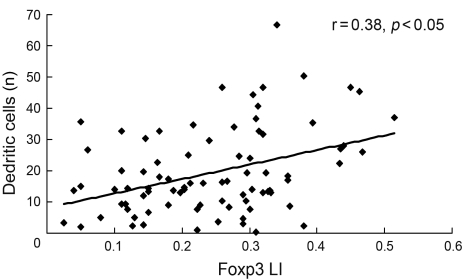Abstract
Purpose
Forkhead box p3 (Foxp3) positive T regulatory cells (Tregs) have a functionally immunosuppressive property that prevents effector cells from acting against self in autoimmune diseases or a tumor. It is known that Tregs may be highly relevant in cancer progression. Dendritic cells (DCs) induce cutaneous immune response, however several studies have suggested that DCs are involved in immunosuppression. The aim of this study is to evaluate the prevalence of Tregs and DCs infiltration in cutaneous premalignant and malignant squamous lesions.
Materials and Methods
We evaluated Tregs and DCs in skin tissue samples obtained from 83 patients with actinic keratosis, Bowen's disease or squamous cell carcinoma by immunohistochemistry.
Results
The prevalence of Tregs and DCs was significantly higher in squamous cell carcinoma and Bowen's disease than in actinic keratosis. In addition, the number of DCs was closely correlated with the prevalence of Tregs, and DCs were also located in direct proximity to Tregs.
Conclusion
Tregs is related to cutaneous squamous tumor progression.
Keywords: Forkhead box p3, T regulatory cells, skin tumor
INTRODUCTION
It is known that actinic keratosis and Bowen's disease, both intraepidermal skin tumors, have a potential progression to squamous cell carcinoma. Skin cancer constitutes one of the most frequent types of malignancies in humans with rapidly increasing worldwide incidences. Ultraviolet radiation (UVR) is an essential risk factor for the development of premalignant as well as malignant skin lesions.1 UVR can function as a complete carcinogen by inducing DNA mutations and by suppressing protective cellular antitumoral immune responses.2 Recent data showed that UVB-dendritic cell (DC) induces regulatory CD4+CD25+ cytotoxic T-lymphocyte-associated antigen-4 (CTLA-4+) T cells.3
Dendritic cells (DCs) induce cutaneous immune response, however, several studies have suggested that DCs are involved in immunosuppression.4,5 DC-derived immunosuppression can result from antigen presentation by immature DCs that lack sufficient accessory molecules. In addition, immature DCs can differentiate into tolerogenic DCs under the influence of IL-10, TNFα and T regulatory cells (Tregs).5 Recently, epidermal expression of CD254 (receptor activator of NF-kappaB ligand, RANKL) has been shown to connect UVR with immunosuppression and tolerogenic phenotype in DCs and expansion of Tregs.6,7 Tregs are thought to be functionally unique population of T cells, and function to maintain immune homeostasis.8-10 Tregs have a functionally immunosuppressive property that inhibits effector cells to act against self in autoimmune diseases or a tumor. Foxp3, a member of the forkhead or winged helix family of transcription factors, is thought to be most reliable marker for Tregs.11,12 Foxp3 protein is responsible for scurfy mouse and human disorder of immune dysregulation, polyendocrinopathy, enteropathy, and X-linked inheritance, both of which are characterized by lack of CD4+CD25+ Tregs.13,14 Tregs may be highly relevant in cancer progression. Elevated numbers of Tregs have been found in cancer patients, and it has been shown that the elimination of Tregs may be used to enhance antitumoral immune responses.15-20 There is, however, limited information describing the prevalence of Tregs infiltration in premalignant and malignant skin lesions. The aim of this study was to evaluate the prevalence of Tregs and DCs infiltration in cutaneous premalignant and malignant squamous lesions by immunohis-tchemistry.
MATERIALS AND METHODS
Patients
Eighty-three patients with actinic keratosis, Bowen's disease or squamous cell carcinoma treated at Dongguk University Kyongju Hospital were enrolled in this study. The characteristics of the study subjects are summarized in Table 1. None of the patients received radiotherapy or chemotherapy before diagnosis.
Table 1.
The Characteristics of Study Subjects
Immunohistochemistry
Skin sections of 4µm thickness were made and spread on poly-L-lysine coated slides. Paraffin sections were immersed in three changes of xylene and hydrated using a graded series of alcohol. Antigen retrieval was performed routinely by immersing the sections in sodium citrate buffer (pH 6.0 for Ki67) or Tris-EDTA buffer (pH 6.0 for Foxp3) in a pressure cooker by autoclaving for 15 minutes. Endogenous peroxidase activity was blocked with 3% hydrogen peroxide for 15 minutes and then incubated with primary antibody for 2 hours at room temperature. Primary antibodies were rabbit polyclonal anti-S100 (DakoCytomation, Carpinteria, CA, USA, dilution 1 : 500), mouse monoclonal anti-Ki67 antibody (Zymed Laboratories, South San Franciso, CA, USA, dilution 1 : 200) and mouse monoclonal anti-Foxp3 antibody (Abcam, Cambridge, UK, dilution 1 : 100). Staining was done with a Dako EnVision kit labeled with peroxidase (DakoCytomation) and developed with 3, 3'-diaminobenzidine tetrahydrochloride (Zymed) as a chromogen. Sections were counterstained for 3 minutes with Meyers hematoxylin and then mounted. As a negative control, rabbit and mouse IgG isotypes were used instead of primary antibody. In addition, double-staining immunohistochemistry was performed in human tonsil with anti-Foxp3 antibody and anti-CD4 antibody (DakoCytomation) to confirm that Foxp3(+) cells were really CD4(+). Second staining was performed with a LSAB+kit labeled with alkaline phosphatase (DakoCytomation) and developed with Permanent Red (DakoCytomation) as a chromogen. The Foxp3 labeling index (LI) was calculated by counting positive cells in 500 lymphocytes throughout entire area of tumor stroma at a magnification of ×400. In the case of Ki67 LI, at least 500 malignant squamous cells were counted throughout entire area of tumor at a magnification of ×400. The number of S100 positive DCs in five randomly selected tumor stroma areas was analyzed at a magnification of ×400 and averaged. To examine the relationship of topographic distribution between S100 positive DCs and Tregs, figures of immunohistochemical staining for S100 and Foxp3 were merged on the Adobe Photoshop 9.0.
Statistical analysis
Pearson correlation and one-way ANOVA were used. Statistical significance was assumed if a p value was less than 0.05. Data were expressed as mean ± standard deviation (SD).
RESULTS
To confirm that Foxp3(+) cells were really CD4(+), double staining immunohistochemistry was done in human tonsil. Most of Foxp3(+) and CD4(+) lymphocytes were present in paracortical area. Some of CD4(+) lymphocytes showed positive signal for Foxp3 (Fig. 1A). Tregs stayed in close proximity to S100(+) DCs (Fig. 1B). Foxp3 LI was 0.28 ± 0.11, 0.27 ± 0.13 and 0.19 ± 0.08 in squamous cell carcinoma, Bowen's disease and actinic keratosis, respectively. As shown in Fig. 2. Foxp3 LI was significantly higher in squamous cell carcinoma and Bowen's disease than in actinic keratosis (p< 0.05). In each disease, there was no significant difference in Foxp3 LI between age and gender (data not shown). In squamous cell carcinoma, Foxp3 LI was 0.28 ± 0.13 and 0.30 ± 0.07 in well differentiation tumors (N = 13) and moderate to poor tumors (N = 14), respectively, and insignificantly related to Ki67 LI. There was also no significant difference in Foxp3 LI between tumor differentiation and Ki67 LI (p> 0.05). The number of S100 positive DCs was 26.45 ± 16.02, 20.21 ± 13.94 and 12.47 ± 7.03 in squamous cell carcinoma, Bowen's disease and actinic keratosis, respectively, As shown in Fig. 3, total DCs infiltration was significantly higher in squamous cell carcinoma and Bowen's disease than in actinic keratosis (p< 0.05). In each disease, there was no significant difference in the number of DCs between age and gender (data not shown). In squamous cell carcinoma, the number of DCs was 22.39 ± 11.76 and 29.60 ± 17.35 in well differentiation tumors (N= 13) and moderate to poor tumors (N = 14), respectively, and insignificantly related to Ki67 LI. There was also no significant difference in the number of DCs between tumor differentiation and Ki67 LI. As shown in Fig. 4, the number of DCs was closely correlated with Foxp3 LI (r = 0.378, p< 0.05).
Fig. 1.
Double-staining immunohistochemistry with anti-Foxp3 antibody (pink) and a anti-CD4 antibody (brown) in human tonsil (A), and combination of immunohistochemical staining for S100 and Foxp3 (B). (A) Some of CD4(+) lymphocytes show positive signal for Foxp3 (arrow). (B) Tregs (arrow) stay in close proximity to S100(+) DC (arrowhead).
Fig. 2.
Foxp3 LI (A) and representative pictures of immunohistochemical staining for Foxp3 (B, C, and D) in actinic keratosis (AK, B), Bowen's disease (BD, C), and squamous cell carcinoma (SCC, D). Foxp3 LI was significantly higher in SCC and BD than in AK (p<0.05).
Fig. 3.
The number of DCs (A) and representative pictures of immunohistochemical staining for S100 in AK (B), BD (C) and SCC (D). The number of DCs was significantly higher in SCC and BD than in AK (p<0.05). DCs, dendritic cells; AK, actinic keratosis; BD, Bowen's disease; SCC, squamous cell carcinoma.
Fig. 4.
Correlation between Foxp3 LI and the number of dendritic cells. The number of DCs was closely correlated with Foxp3 LI (r = 0.378, p< 0.05).
DISCUSSION
For the first time, this study performed in situ analysis of Tregs in cutaneous premalignant and malignant squamous lesions, and showed that the population of Tregs and DCs were increased in Bowen's disease and cutaneous squamous cell carcinoma compared to actinic keratosis. In addition, Tregs infiltration was closely related with the number of infiltrating DCs, and Tregs were also located in direct proximity to DCs.
Naturally arising CD4+CD25+ Tregs characteristically express CD25, CTLA-4, glucocorticoid-induced tumor necrosis factor receptor family related gene (GITR), surface transforming growth factor-β (TGF-β), and Foxp3. CD25 is a critical molecule for proliferation and survival of CD4+CD25+ Tregs.21 However, CD25 is not a suitable marker to define Tregs because activated T cells generally express CD25. Compelling studies have revealed that CTLA-4 and TGF-β play roles in the suppressive activity of CD4+CD25+ Tregs against CD4+ or CD8+ T cells, although they are not expressed exclusively in Tregs. Experiments with Foxp3-overexpressing transgenic or Foxp3 gene-depleted mice and other studies have shown that Foxp3 is a master control gene for the development and function of natural CD4+CD25+ Tregs.21-24 Thus, Foxp3 is thought to be a suitable single marker for detecting CD4+CD25+ Tregs.
In murine models, Tregs inhibit the antitumor immune response mediated by CD4+CD25- T cells and CD8+ cytotoxic T cells.25-28 Population of Tregs in tumor infiltrating lymphocytes are significantly larger than in normal tissue in several malignancies.16-20 Moreover, Tregs infiltration is correlated with tumor progression in pancreatic ductal adenocarcinoma and gastric cancer.19,20 In this study, the population of Tregs were also increased in Bowen's disease and cutaneous squamous cell carcinoma compared to actinic keratosis. Thus, Tregs may highly be relevant in several human cancer progression. Since high Tregs infiltration reduces the anti-tumor immunity, Tregs infiltration has been suggested to be poor prognostic factor in several malignancies.17,20,29-31 On the contrary, recent studies showed that clinical outcome is not dependent on Tregs infiltration in renal cell cancer and colon cancer.32,33 Moreover, there is close correlation between Tregs infiltration and good survival in follicular lymphoma.34 The present study revealed that Tregs infiltration was not correlated with Ki67 LI in squamous cell carcinoma. Overall, it remains controversial as to whether Tregs infiltration is related to clinical behaviour.
The present study revealed that DCs infiltration was significantly in Bowen's disease and squamous cell carcinoma compared to actinic kertatosis. Moreover, the number of DCs was strongly related to Tregs infiltration, and DC stayed in close proximity to Tregs. A recent report showed that S100 positive DCs infiltration were correlated with Tregs infiltration in colon cancers, and also demonstrated that S100 positive DCs was primarily immature DCs.35 The function of DC effector strictly depend on both maturation stage and on environmental, anti-inflammatory or pro-inflammatory signals.36 Mature DCs have been regarded as inducers of T-cell immunity and vigorous T-cell proliferative responses, whereas immature DCs have been considered as inducers of T reg cells with inherent low ability to proliferate in response to mitogens or antigens.36 It is known that RANK and RANKL are key regulators of bone remodeling, mammary gland formation, lymph node development and T-cell/DC communication.6 RANKL overexpression in keratinocytes resulted in functional alterations of epidermal DCs and systemic increases of Tregs.6 RANK-RANKL signaling between RANK-expressing epidermal DCs and RANKL-overexpressing keratinocytes in K14-RANKL transgenic epidermis resulted in the up-regulation of DEC205 on epidermal DCs, a marker that has previously been associated with the induction of a tolerogenic phenotype in DCs.7 Moreover, DCs co-cultured with Tregs may also down-regulate the expression of costimulatory molecules, release large quantities of IL-10 and become unable to properly trigger T-cell activation.37,38 Recent studies also demonstrated direct contact of Treg with DC in vivo.39-41 Taken together, Tregs may act by directly targeting effector T cells, by competing with pathogenic T cells for access to antigen presenting cells (APCs) or by directly targeting APCs.
In conclusion, this study shows that Tregs are related to cutaneous squamous tumor progression.
References
- 1.Urbach F. Ultraviolet radiation and skin cancer of humans. J Photochem Photobiol B. 1997;40:3–7. doi: 10.1016/s1011-1344(97)00029-8. [DOI] [PubMed] [Google Scholar]
- 2.Beissert S, Loser K. Molecular and cellular mechanisms of photocarcinogenesis. Photochem Photobiol. 2008;84:29–34. doi: 10.1111/j.1751-1097.2007.00231.x. [DOI] [PubMed] [Google Scholar]
- 3.Simon JC, Hara H, Denfeld RW, Martin S. UVB-irradiated dendritic cells induce nonproliferating, regulatory type T cells. Skin Pharmacol Appl Skin Physiol. 2002;15:330–334. doi: 10.1159/000064537. [DOI] [PubMed] [Google Scholar]
- 4.Lutz MB, Schuler G. Immature, semi-mature and fully mature dendritic cells: which signals induce tolerance or immunity? Trends Immunol. 2002;23:445–449. doi: 10.1016/s1471-4906(02)02281-0. [DOI] [PubMed] [Google Scholar]
- 5.Enk AH. Dendritic cells in tolerance induction. Immunol Lett. 2005;99:8–11. doi: 10.1016/j.imlet.2005.01.011. [DOI] [PubMed] [Google Scholar]
- 6.Loser K, Mehling A, Loeser S, Apelt J, Kuhn A, Grabbe S, et al. Epidermal RANKL controls regulatory T-cell numbers via activation of dendritic cells. Nat Med. 2006;12:1372–1379. doi: 10.1038/nm1518. [DOI] [PubMed] [Google Scholar]
- 7.Mahnke K, Qian Y, Knop J, Enk AH. Induction of CD4+/CD25+ regulatory T cells by targeting of antigens to immature dendritic cells. Blood. 2003;101:4862–4869. doi: 10.1182/blood-2002-10-3229. [DOI] [PubMed] [Google Scholar]
- 8.Jonuleit H, Schmitt E, Stassen M, Tuettenberg A, Knop J, Enk AH. Identification and functional characterization of human CD4(+)CD25(+) T cells with regulatory properties isolated from peripheral blood. J Exp Med. 2001;193:1285–1294. doi: 10.1084/jem.193.11.1285. [DOI] [PMC free article] [PubMed] [Google Scholar]
- 9.Ng WF, Duggan PJ, Ponchel F, Matarese G, Lombardi G, Edwards AD, et al. Human CD4(+)CD25(+) cells: a naturally occurring population of regulatory T cells. Blood. 2001;98:2736–2744. doi: 10.1182/blood.v98.9.2736. [DOI] [PubMed] [Google Scholar]
- 10.Sakaguchi S, Sakaguchi N, Asano M, Itoh M, Toda M. Immunologic self-tolerance maintained by activated T cells expressing IL-2 receptor alpha-chains (CD25). Breakdown of a single mechanism of self-tolerance causes various autoimmune diseases. J Immunol. 1995;155:1151–1164. [PubMed] [Google Scholar]
- 11.Fontenot JD, Gavin MA, Rudensky AY. Foxp3 programs the development and function of CD4+CD25+ regulatory T cells. Nat Immunol. 2003;4:330–336. doi: 10.1038/ni904. [DOI] [PubMed] [Google Scholar]
- 12.Hori S, Nomura T, Sakaguchi S. Control of regulatory T cell development by the transcription factor Foxp3. Science. 2003;299:1057–1061. [PubMed] [Google Scholar]
- 13.Brunkow ME, Jeffery EW, Hjerrild KA, Paeper B, Clark LB, Yasayko SA, et al. Disruption of a new forkhead/winged-helix protein, scurfin, results in the fatal lymphoproliferative disorder of the scurfy mouse. Nat Genet. 2001;27:68–73. doi: 10.1038/83784. [DOI] [PubMed] [Google Scholar]
- 14.Chatila TA, Blaeser F, Ho N, Lederman HM, Voulgaropoulos C, Helms C, et al. JM2, encoding a fork head-related protein, is mutated in X-linked autoimmunity-allergic disregulation syndrome. J Clin Invest. 2000;106 doi: 10.1172/JCI11679. [DOI] [PMC free article] [PubMed] [Google Scholar]
- 15.Shimizu J, Yamazaki S, Sakaguchi S. Induction of tumor immunity by removing CD25+CD4+ T cells: a common basis between tumor immunity and autoimmunity. J Immunol. 1999;163:5211–5218. [PubMed] [Google Scholar]
- 16.Woo EY, Chu CS, Goletz TJ, Schlienger K, Yeh H, Coukos G, et al. Regulatory CD4(+)CD25(+) T cells in tumors from patients with early-stage non-small cell lung cancer and late-stage ovarian cancer. Cancer Res. 2001;61:4766–4772. [PubMed] [Google Scholar]
- 17.Liyanage UK, Moore TT, Joo HG, Tanaka Y, Herrmann V, Doherty G, et al. Prevalence of regulatory T cells is increased in peripheral blood and tumor microenvironment of patients with pancreas or breast adenocarcinoma. J Immunol. 2002;169:2756–2761. doi: 10.4049/jimmunol.169.5.2756. [DOI] [PubMed] [Google Scholar]
- 18.Ormandy LA, Hillemann T, Wedemeyer H, Manns MP, Greten TF, Korangy F. Increased populations of regulatory T cells in peripheral blood of patients with hepatocellular carcinoma. Cancer Res. 2005;65:2457–2464. doi: 10.1158/0008-5472.CAN-04-3232. [DOI] [PubMed] [Google Scholar]
- 19.Mizukami Y, Kono K, Kawaguchi Y, Akaike H, Kamimura K, Sugai H, et al. Localisation pattern of Foxp3+ regulatory T cells is associated with clinical behaviour in gastric cancer. Br J Cancer. 2008;98:148–153. doi: 10.1038/sj.bjc.6604149. [DOI] [PMC free article] [PubMed] [Google Scholar]
- 20.Hiraoka N, Onozato K, Kosuge T, Hirohashi S. Prevalence of Foxp3+ regulatory T cells increases during the progression of pancreatic ductal adenocarcinoma and its premalignant lesions. Clin Cancer Res. 2006;12:5423–5434. doi: 10.1158/1078-0432.CCR-06-0369. [DOI] [PubMed] [Google Scholar]
- 21.Sakaguchi S. Naturally arising Foxp3-expressing CD25+CD4+ regulatory T cells in immunological tolerance to self and non-self. Nat Immunol. 2005;6:345–352. doi: 10.1038/ni1178. [DOI] [PubMed] [Google Scholar]
- 22.von Boehmer H. Mechanisms of suppression by suppressor T cells. Nat Immunol. 2005;6:338–344. doi: 10.1038/ni1180. [DOI] [PubMed] [Google Scholar]
- 23.Fontenot JD, Rudensky AY. A well adapted regulatory contrivance: regulatory T cell development and the forkhead family transcription factor Foxp3. Nat Immunol. 2005;6:331–337. doi: 10.1038/ni1179. [DOI] [PubMed] [Google Scholar]
- 24.Fontenot JD, Rasmussen JP, Williams LM, Dooley JL, Farr AG, Rudensky AY. Regulatory T cell lineage specification by the forkhead transcription factor Foxp3. Immunity. 2005;22:329–341. doi: 10.1016/j.immuni.2005.01.016. [DOI] [PubMed] [Google Scholar]
- 25.Chen ML, Pittet MJ, Gorelik L, Flavell RA, Weissleder R, von Boehmer H, et al. Regulatory T cells suppress tumor-specific CD8 T cell cytotoxicity through TGF-bata signals in vivo. Proc Natl Acad Sci U S A. 2005;102:419–424. doi: 10.1073/pnas.0408197102. [DOI] [PMC free article] [PubMed] [Google Scholar]
- 26.Shimizu J, Yamazaki S, Sakaguchi S. Induction of tumor immunity by removing CD25+CD4+ T cells: a common basis between tumor immunity and autoimmunity. J Immunol. 1999;163:5211–5218. [PubMed] [Google Scholar]
- 27.Onizuka S, Tawara I, Shimizu J, Sakaguchi S, Fujita T, Nakayama E. Tumor rejection by in vivo administration of anti-CD25 (interleukin-2 receptor α) monoclonal antibody. Cancer Res. 1999;59:3128–3133. [PubMed] [Google Scholar]
- 28.Nishikawa H, Kato T, Tawara I, Takemitsu T, Saito K, Wang L, et al. Accelerated chemically induced tumor development mediated by CD4+CD25+ regulatory T cells in wild-type hosts. Proc Natl Acad Sci U S A. 2005;102:9253–9257. doi: 10.1073/pnas.0503852102. [DOI] [PMC free article] [PubMed] [Google Scholar]
- 29.Curiel TJ, Coukos G, Zou L, Alvarez X, Cheng P, Mottram P, et al. Specific recruitment of regulatory T cells in ovarian carcinoma fosters immune privilege and predicts reduced survival. Nat Med. 2004;10:942–949. doi: 10.1038/nm1093. [DOI] [PubMed] [Google Scholar]
- 30.Alvaro T, Lejeune M, Salvado MT, Bosch R, García JF, Jaén J, et al. Outcome in Hodgkin's lymphoma can be predicted from the presence of accompanying cytotoxic and regulatory T cells. Clin Cancer Res. 2005;11:1467–1473. doi: 10.1158/1078-0432.CCR-04-1869. [DOI] [PubMed] [Google Scholar]
- 31.Wolf D, Hochegger K, Wolf AM, Rumpold HF, Gastl G, Tilg H, et al. The expression of the regulatory T cell-specific forkhead box transcription factor FoxP3 is associated with poor prognosis in ovarian cancer. Clin Cancer Res. 2005;11:8326–8331. doi: 10.1158/1078-0432.CCR-05-1244. [DOI] [PubMed] [Google Scholar]
- 32.Siddiqui SA, Frigola X, Bonne-Annee S, Mercader M, Kuntz SM, Krambeck AE, et al. Tumor infiltrating Foxp3-CD4+CD25+ T cells predict poor survival in renal cell carcinoma. Clin Cancer Res. 2007;13:2075–2081. doi: 10.1158/1078-0432.CCR-06-2139. [DOI] [PubMed] [Google Scholar]
- 33.Loddenkemper C, Schernus M, Noutsias M, Stein H, Thiel E, Nagorsen D. In situ anlaysis of FOXP3+ egulatory T cells in human colorectal cancer. J Transl Med. 2006;4:52. doi: 10.1186/1479-5876-4-52. [DOI] [PMC free article] [PubMed] [Google Scholar]
- 34.Carreras J, Lopez-Guillermo A, Fox BC, Colomo L, Martinez A, Roncador G, et al. High numbers of tumor-infiltrating FOXP3-positive regulatory T cells are associated with improved overall survival in follicular lymphoma. Blood. 2006;108:2957–2964. doi: 10.1182/blood-2006-04-018218. [DOI] [PubMed] [Google Scholar]
- 35.Nagorsen D, Voigt S, Berg E, Stein H, Thiel E, Loddenkemper C. Tumor-infiltrating macrophages and dendritic cells in human colorectal cancer: relation to local regulatory T cells, systemic T-cell response against tumor-associated antigens and survival. J Transl Med. 2007;5:62. doi: 10.1186/1479-5876-5-62. [DOI] [PMC free article] [PubMed] [Google Scholar]
- 36.Rutella S, Lemoli RM. Regulatory T cells and tolerogenic dendritic cells: from basic biology to clinical applications. Immunol Lett. 2004;94:11–26. doi: 10.1016/j.imlet.2004.04.015. [DOI] [PubMed] [Google Scholar]
- 37.Misra N, Bayry J, Lacroix-Desmazes S, Kazatchkine MD, Kaveri SV. Cutting edge human CD4+CD25+ T cells restrain the maturation and antigen-presenting function of dendritic cells. J Immunol. 2004;172:4676–4680. doi: 10.4049/jimmunol.172.8.4676. [DOI] [PubMed] [Google Scholar]
- 38.Cederbom L, Hall H, Ivars F. CD4+CD25+ regulatory T cells down-regulate co-stimulatory molecules on antigen-presenting cells. Eur J Immunol. 2000;30:1538–1543. doi: 10.1002/1521-4141(200006)30:6<1538::AID-IMMU1538>3.0.CO;2-X. [DOI] [PubMed] [Google Scholar]
- 39.Tadokoro CE, Shakhar G, Shen S, Ding Y, Lino AC, Maraver A, et al. Regulatory T cells inhibit stable contacts between CD4+ T cells and dendritic cells in vivo. J Exp Med. 2006;203:505–511. doi: 10.1084/jem.20050783. [DOI] [PMC free article] [PubMed] [Google Scholar]
- 40.Tang Q, Adams JY, Tooley AJ, Bi M, Fife BT, Serra P, et al. Visualizing regulatory T cell control of autoimmune responses in nonobese diabetic mice. Nat Immunol. 2006;7:83–92. doi: 10.1038/ni1289. [DOI] [PMC free article] [PubMed] [Google Scholar]
- 41.Mahnke K, Ring S, Johnson TS, Schallenberg S, Schönfeld K, Storn V, et al. Induction of immunosuppressive functions of dendritic cells in vivo by CD4+CD25+ regulatory T cells: role of B7-H3 expression and antigen presentation. Eur J Immunol. 2007;37:2117–2126. doi: 10.1002/eji.200636841. [DOI] [PubMed] [Google Scholar]







